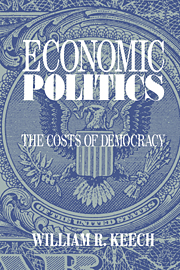Book contents
- Frontmatter
- Contents
- List of figures and tables
- Preface and acknowledgments
- INTRODUCTION
- MODELS OF ROUTINE POLITICS
- THE SOURCES AND AUTHORITY OF MACROECONOMIC GOALS
- INSTITUTIONS AND PROCESSES
- 7 Discretion and Accountability in the Fiscal Policy Process
- 8 Discretion and Accountability in the Monetary Policy Process
- CONCLUSION
- References
- Index
7 - Discretion and Accountability in the Fiscal Policy Process
Published online by Cambridge University Press: 05 June 2012
- Frontmatter
- Contents
- List of figures and tables
- Preface and acknowledgments
- INTRODUCTION
- MODELS OF ROUTINE POLITICS
- THE SOURCES AND AUTHORITY OF MACROECONOMIC GOALS
- INSTITUTIONS AND PROCESSES
- 7 Discretion and Accountability in the Fiscal Policy Process
- 8 Discretion and Accountability in the Monetary Policy Process
- CONCLUSION
- References
- Index
Summary
Fiscal policy consists of public decisions about government expenditures and revenues. Spending policy and taxation policy have always been of interest in their own right, but at least since the 1930s, spending and taxing and the balance between them have been seen by at least some economists as having controllable consequences for the performance of the macroeconomy. For example, Keynesians have advocated active discretionary manipulation of the size of the budget deficit (or surplus) to stabilize the economy, to reduce unemployment, and to shift the path of economic growth. The Kennedy-Johnson tax cut of 1964 is seen by Keynesians as a successful example of how fiscal policy can increase prosperity by increasing aggregate demand. Supply side economists have acknowledged the success of that tax cut, but explain its success in terms of increasing aggregate supply, rather than demand. They would defend the Economic Recovery Tax Act of 1981 on the same, supply oriented grounds.
Causality goes in the other direction as well. That is, the performance of the economy has an effect on the size of the government's deficit (or surplus). Specifically, when the economy expands, revenues may rise faster than expenditures, thus reducing a deficit. And when the economy goes into a recession, expenditures may rise (e.g., because of increased unemployment compensation claims) while revenues fall, because of declining incomes and reduced economic activity.
- Type
- Chapter
- Information
- Economic PoliticsThe Costs of Democracy, pp. 153 - 183Publisher: Cambridge University PressPrint publication year: 1995



